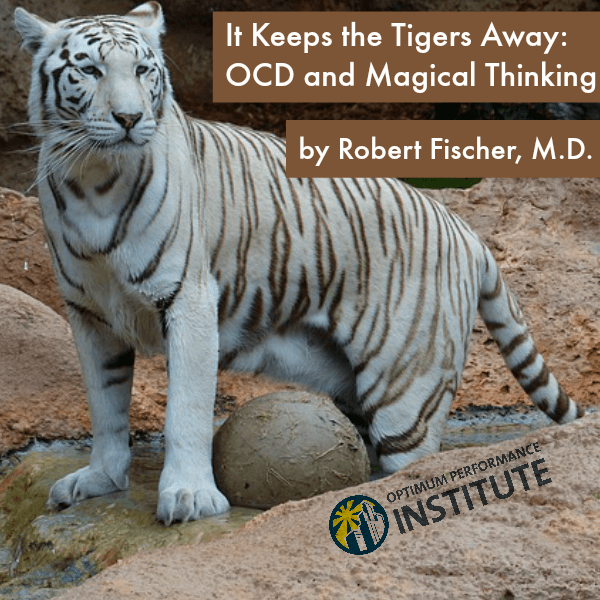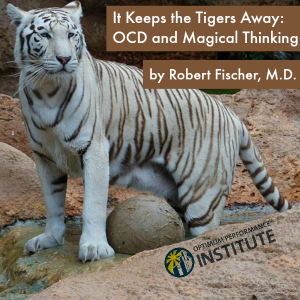
Magical Thinking OCD: It Keeps the Tigers Away
Magical thinking obsessive-compulsive disorder (OCD) creates a unique perspective on the world. It’s like having a little voice inside your head constantly whispering irrational beliefs and fears. But for young adults struggling with OCD, magical thinking can seem like the only way to keep the metaphorical tigers at bay.
According to the National Institute of Mental Health, OCD is highly prevalent in young adults, especially in young adult females. For young people struggling with OCD, magical thinking can become an intricate and challenging part of their daily lives. From checking if the stove is turned off a hundred times to avoiding certain numbers or colors, these rituals may seem peculiar to others, but for young adults with OCD, these thoughts and rituals can feel like they serve an important purpose.
What Is Magical Thinking OCD?
Magical thinking OCD is a subtype of OCD characterized by irrational beliefs and behaviors rooted in superstition or magical thoughts. Young adults with magical thinking OCD may repeat specific phrases or engage in rituals, or compulsions, to counteract fears through thoughts or actions they feel are “magical”.
For example, a young adult with magical thinking might turn off the lights a specific number of times thinking it will prevent someone they love from getting hurt. Young adults with magical thinking OCD experience these intrusive thoughts and the accompanying compulsions in a way that is consuming and disrupts multiple areas of their lives. Young adults may also experience feelings of guilt about causing harm and engage in obsessions and compulsions related to these thoughts.
Magical Thinking OCD Examples
Here are some of the most common examples of magical thinking OCD. If you think any of these apply to you or your young adult, taking an OCD test is a good first step to identifying possible symptoms of OCD.
Number obsession
One common example of magical thinking OCD is the obsession with certain numbers. A young adult might feel compelled to perform actions or rituals a specific number of times, believing that it will bring them good luck or prevent something bad from happening.
Color avoidance
Another manifestation of magical thinking OCD is the avoidance of certain colors. Young adults affected by this type of OCD may feel intense fear or discomfort when exposed to specific colors and go to great lengths to avoid them, believing that they are somehow associated with negative outcomes.
Protective objects
Some young adults with magical thinking OCD may also develop a dependence on protective objects. These objects, often referred to as “lucky charms,” provide a sense of security and ward off perceived threats or harm. For example, a young adult with magical thinking OCD might carry around a specific item like a lucky coin or a talisman in their pocket, believing that it will protect them from danger.
Ritualistic phrases
Magical thinking OCD can also manifest through the repetition of certain phrases or words. Young adults may feel compelled to utter these phrases repeatedly and do specific things at specific times, believing that they have the power to prevent something negative from happening. This behavior can become incredibly time-consuming and may interfere with daily activities or relationships. In severe cases of magical thinking OCD, this compulsion can be deeply disruptive and impede someone’s ability to function and succeed in their everyday life.
Order and symmetry obsession
Another common example of magical thinking OCD is the obsession with order and symmetry. Young adults affected by this type of OCD may feel an overwhelming need to arrange objects in a specific way or follow strict patterns, believing that it will bring them a sense of control and prevent chaos or harm.
Superstitions
According to a paper published in the Journal of Behavior Research and Therapy, magical thinking OCD often involves the belief in superstitions, such as avoiding cracks, black cats, or walking under ladders, in the form of superstitions. These superstitions stem from a fear of bad luck or negative consequences associated with these actions. While they may seem irrational to others, young adults with magical thinking OCD find solace in adhering to these beliefs, hoping that they can somehow control the outcome of their lives. They may even rely on wearing a lucky shirt to bring them good fortune.
Coincidences
Magical thinking OCD can also manifest in the form of obsessing over coincidences. Young adults with this type of OCD may attribute deeper meaning or significance to everyday occurrences, believing that they are somehow connected to their thoughts or actions. For example, if they think a negative thought and then witness something negative happening shortly after, they may convince themselves that their thought caused the event. This can lead to a constant sense of responsibility and guilt, as well as an overwhelming need to control their thoughts and actions to prevent negative outcomes.
Examples of magical thinking OCD obsessions
- Young adults may feel they need to make sure they are only thinking good thoughts when they buy a candle. Otherwise, the negativity will be infused into the candle, and will “curse” their home.
- Young adults may think that they have to avoid stepping on the cracks or something similarly disastrous will happen to their loved ones.
- Young adults may feel they have to avoid a certain color combination in their clothing because they believe it will bring them bad luck or negative energy.
- Young adults may think that if they share the news that they got a promotion at work, something bad will happen to their family members as a consequence.
Examples of magical thinking OCD compulsions
- A young person may obsessively count their steps, believing that completing a specific number will ensure good luck for the day.
- A young adult may engage in excessive handwashing, convinced that if they don’t wash their hands a certain number of times, they will become contaminated with germs and fall ill.
- A young adult may feel the urge to touch objects in a certain sequence or pattern, convinced that if they deviate from this ritual, something bad will happen to them or their loved ones.
- A young person may constantly seek reassurance from others, repeatedly asking for confirmation or validation to alleviate their fears if they have not completed a ritual or compulsion.
A young adult with magical thinking OCD
There once was a young adult sitting around waiting for his train at a station in Los Angeles. He was constantly snapping and clicking his fingers. Intrigued, a passerby who had been observing him asked why he kept doing this. “It keeps the tigers away,” he responded. “But there have been no tigers in L.A. for centuries,” the observer replied. The response? “I must be doing a great job.”
In this example, the young adult might have anxious thoughts such as: What if I stop snapping my fingers? Will the tiger appear? I’m not taking the chance. It’s better to keep snapping and ward off danger. It’s worked so far. I know it’s odd, but I need to keep doing it, just in case. This can be a constant battle for young adults who are affected, as their minds become consumed with rituals and compulsions aimed at preventing harm or bringing good luck.
What Causes Magical Thinking OCD?
Magical thinking OCD is believed to result from a complex interaction between genetic, biological, and environmental factors, such as trauma, abnormalities in brain structure, stressful life events, and a family history of OCD.
How to Stop and Get Rid of Magical Thinking OCD
Stopping and getting rid of magical thinking in OCD can be a challenging process, but it is possible with the right approach. Here are some strategies that may help:
1. Exposure and response prevention (ERP) therapy
ERP therapy is a specific form of CBT that involves an ERP therapist gradually exposing young adults to situations or thoughts that trigger their magical thinking while helping them refrain from engaging in compulsive behaviors.
For example, if you or your young adult believes that touching a certain object will prevent bad things from happening, ERP would involve gradually exposing young adults to situations where they resist the compulsion to touch that object. Over time, this can help reduce the anxiety associated with magical thinking and break the cycle of obsessions and compulsions.
2. Cognitive behavioral therapy (CBT)
CBT is a widely recognized and effective treatment for OCD. It focuses on identifying and challenging irrational thoughts and beliefs, including magical thinking.
3. Mindfulness and meditation
Practicing mindfulness and meditation can help increase awareness of thoughts and emotions without judgment or attachment. This can be particularly helpful in managing anxiety and reducing the intensity of obsessive or ruminating thoughts.
4. Medication
In some cases, medication may be prescribed by a healthcare professional to help manage the symptoms of OCD, including magical thinking. Antidepressant medications, such as selective serotonin reuptake inhibitors (SSRIs), are effective in reducing the severity of obsessive-compulsive symptoms.
5. Support groups
Connecting with others who are going through similar experiences can provide a sense of validation and understanding. Joining a support group for OCD can offer a safe space for young adults to discuss struggles with magical thinking and learn from others who have successfully overcome it.
6. Self-Care
Helping young adults take care of themselves physically and emotionally is essential in managing magical thinking and OCD. Engaging in self-care activities such as exercise, getting enough sleep, eating a balanced diet, and practicing relaxation techniques can help reduce stress and improve overall well-being.
The Effect of Magical Thinking on Young Adults
With OCD, even though the rational self can often readily acknowledge that the rituals are strange (which often leads to shame and fear that can delay seeking treatment: “If they knew I had these crazy/scary thoughts they’d lock me away!”), young adults can convince themselves through magical thinking that the rituals have meaning and are keeping them safe. That’s why they keep doing them.
- Difficulty in Daily Life: Simple actions such as getting dressed or going grocery shopping can become overwhelming challenges, as they constantly have to navigate through their intricate belief system.
- Strained Relationships: Furthermore, the constant need for control and avoidance of triggers can lead to isolation and strained relationships. Friends and family may not understand OCD and the reasoning behind the rituals and may become frustrated or confused by a young adult’s behavior. This can create a rift in relationships, as the person with OCD may feel misunderstood and unsupported.
- School Issues: Other issues can happen in school. Papers don’t get turned in because they haven’t gotten the wording “just right” and need to keep starting all over. They feel they have to re-read passages in textbooks, which takes a lot of time, often leaving them unprepared because they don’t make it through all of the material for a test. Or they may refuse to go to school altogether.
- Avoidance: Young adults don’t want people to know that feel they have to perform a compulsion to prevent bad things from happening, so they avoid situations where it won’t be easy to perform the rituals. This can hold them back from important opportunities in life, including at school, work, and in personal relationships.
- Failure to Launch: The overwhelming challenges of navigating through their intricate belief system, coupled with strained relationships and the reinforcement of magical thinking, can significantly hinder young adults with OCD causing a failure to launch into adulthood.
Is There a Cure for Magical Thinking OCD?
There is not a definitive cure for magical thinking OCD, however, there is hope for managing and alleviating the symptoms. Treatment for magical thinking OCD can help young adults through a combination of therapy, medication, and self-help strategies.
Magical Thinking OCD Treatment
The good news for young adults with magical thinking OCD, there is hope! We can redirect neuropathways. We can learn more skillful ways of coping with anxiety, and we can challenge the need to perform compulsions, step-by-step and face the metaphorical tigers so they stay in the zoo. With OCD, it is essential to reach the end goal of creating a life worth living. When time is freed up from obsessions and compulsions, a world of opportunity awaits!
At Optimum Performance Institute (OPI) we treat the whole person not just the diagnosis, we facilitate dealing with the OCD symptoms by providing opportunities to feel more comfortable socially, to develop one’s passions, and to find joy, express it, and share it. Using a Cognitive Behavior Therapy (CBT) approach, which seems to be the most beneficial in addition to the skillful use of medication, when appropriate, we’ll help you or your young adult move beyond the limitations of OCD.
In the meantime, for more information on OPI residential programs and our measures to help reduce failure to launch obstacles for young adults with OCD, call us at 818-906-4884 or click HERE to submit an online form. We’ll be in touch promptly.

